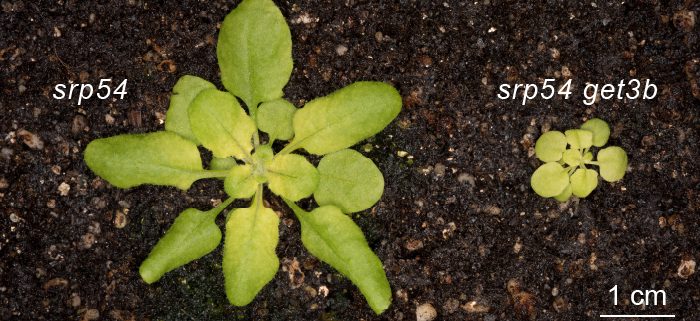Home Delivery for Chloroplast Membrane Proteins
By Donna Fernandez and Stacy Anderson, Department of Botany, University of Wisconsin-Madison, Madison, Wisconsin 53706
Background: For photosynthesis to occur, proteins must be synthesized and delivered to the internal chloroplast membranes. The delivery vehicles (targeting factors) for some of the most abundant proteins have been identified. However, other delivery routes have been more elusive. We wanted to find the targeting factors that deliver a special class of small membrane proteins, known as tail-anchored proteins, because they play important roles in chloroplast development. In other cellular regions, a protein called GET3 delivers tail-anchored proteins to their destinations. Chloroplasts differ significantly from the rest of a plant cell due to their distinct evolutionary history and membrane topology. In this study, we investigated if a protein similar to GET3, called GET3B, acts as a targeting factor in chloroplasts.
Question: Does GET3B function as a targeting factor within chloroplasts?
Findings: We examined GET3B’s structure and function in wildtype and mutant Arabidopsis plants. First, we found that GET3B’s structure is very similar to GET3. Second, we showed that GET3B selectively binds a tail-anchored protein that functions in the internal membranes where photosynthesis takes place. Third, we found that if GET3B mutations are combined with mutations affecting SRP54, another chloroplast targeting factor, plant growth is severely impaired, rates of photosynthesis are reduced, and multiple photosynthesis-related proteins become less abundant. Finally, we show that GET3B’s function is dependent on its ability to hydrolyze ATP, a feature associated with function as a targeting factor.
Next steps: GET3B likely serves a targeting factor for multiple proteins. A future challenge will be to identify these proteins and determine what features allow them to interact with GET3B. We also need to identify what protein or proteins in the internal membranes act as the receptor for GET3B.
Stacy A. Anderson, Manasa B. Satyanarayan, Ryan L. Wessendorf, Yan Lu, and Donna E. Fernandez. (2021). A homolog of Guided Entry of Tail-anchored proteins3 functions in membrane-specific protein targeting in chloroplasts of Arabidopsis. Plant Cell. https://doi.org/10.1093/plcell/koab145.




